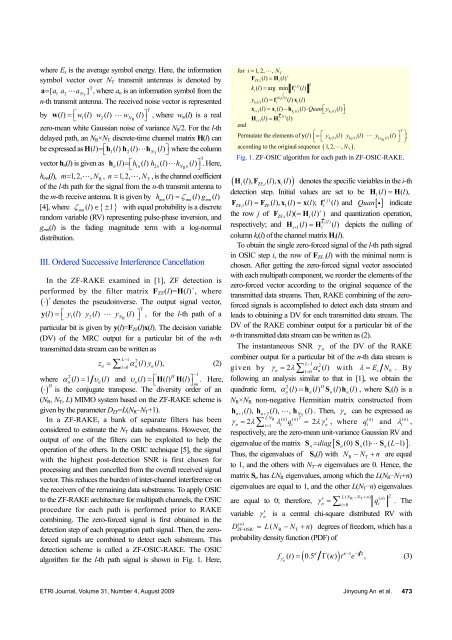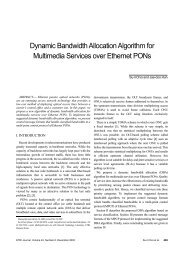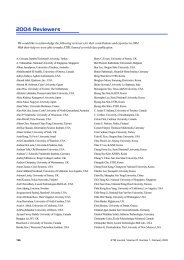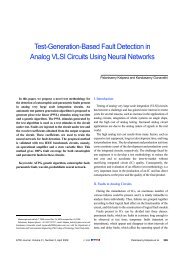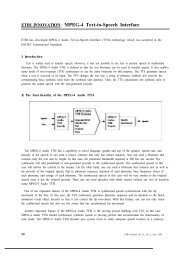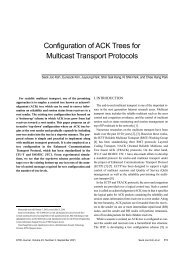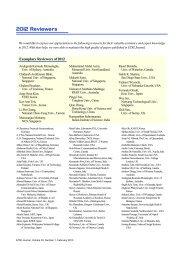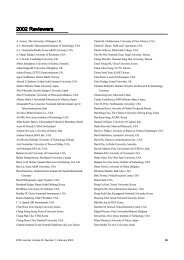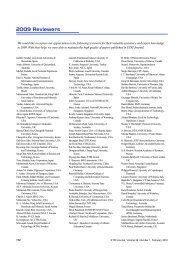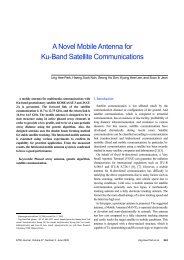An Ordered Successive Interference Cancellation ... - ETRI Journal
An Ordered Successive Interference Cancellation ... - ETRI Journal
An Ordered Successive Interference Cancellation ... - ETRI Journal
You also want an ePaper? Increase the reach of your titles
YUMPU automatically turns print PDFs into web optimized ePapers that Google loves.
where E s is the average symbol energy. Here, the information<br />
symbol vector over N T transmit antennas is denoted by<br />
T<br />
a=<br />
[ a1 a2a N<br />
] , where a<br />
T<br />
n is an information symbol from the<br />
n-th transmit antenna. The received noise vector is represented<br />
T<br />
by w() l = ⎡ ⎣<br />
w1() l w2() l wN<br />
() l ⎤ ,<br />
R ⎦<br />
where w m (l) is a real<br />
zero-mean white Gaussian noise of variance N 0 /2. For the l-th<br />
delayed path, an N R ×N T discrete-time channel matrix H(l) can<br />
be expressed as H() l = ⎡ ⎣<br />
h1() l h2() l hN<br />
() l ⎤<br />
T ⎦<br />
where the column<br />
T<br />
vector h n (l) is given as hn() l = ⎡ ⎣<br />
h1 n() l h2n() l hN () .<br />
Rn<br />
l ⎤ ⎦<br />
Here,<br />
h mn (l), m= 1, 2, , NR<br />
, n= 1, 2, , NT<br />
, is the channel coefficient<br />
of the l-th path for the signal from the n-th transmit antenna to<br />
the m-th receive antenna. It is given by hmn () l = ζ<br />
mn<br />
() l gmn<br />
() l<br />
[4], where ζ () l mn<br />
∈ { ± 1}<br />
with equal probability is a discrete<br />
random variable (RV) representing pulse-phase inversion, and<br />
g mn (l) is the fading magnitude term with a log-normal<br />
distribution.<br />
III. <strong>Ordered</strong> <strong>Successive</strong> <strong>Interference</strong> <strong>Cancellation</strong><br />
In the ZF-RAKE examined in [1], ZF detection is<br />
performed by the filter matrix F ZF (l)=H(l) + , where<br />
() ⋅<br />
+<br />
denotes the pseudoinverse. The output signal vector,<br />
T<br />
y() l = ⎡ ⎣<br />
y1() l y2() l yN<br />
() l ⎤ ,<br />
R ⎦<br />
for the l-th path of a<br />
particular bit is given by y(l)=F ZF (l)x(l). The decision variable<br />
(DV) of the MRC output for a particular bit of the n-th<br />
transmitted data stream can be written as<br />
L−1 2<br />
n<br />
α<br />
l = 0 n n<br />
z = ∑ () l y (), l<br />
(2)<br />
where α<br />
2 n() l = 1 υn()<br />
l and υ () () H<br />
n<br />
l = ⎡ ⎣<br />
H l H () l ⎤ ⎦<br />
. Here,<br />
nn<br />
() ⋅<br />
H<br />
is the conjugate transpose. The diversity order of an<br />
(N R , N T , L) MIMO system based on the ZF-RAKE scheme is<br />
given by the parameter D ZF =L(N R –N T +1).<br />
In a ZF-RAKE, a bank of separate filters has been<br />
considered to estimate the N T data substreams. However, the<br />
output of one of the filters can be exploited to help the<br />
operation of the others. In the OSIC technique [5], the signal<br />
with the highest post-detection SNR is first chosen for<br />
processing and then cancelled from the overall received signal<br />
vector. This reduces the burden of inter-channel interference on<br />
the receivers of the remaining data substreams. To apply OSIC<br />
to the ZF-RAKE architecture for multipath channels, the OSIC<br />
procedure for each path is performed prior to RAKE<br />
combining. The zero-forced signal is first obtained in the<br />
detection step of each propagation path signal. Then, the zeroforced<br />
signals are combined to detect each substream. This<br />
detection scheme is called a ZF-OSIC-RAKE. The OSIC<br />
algorithm for the l-th path signal is shown in Fig. 1. Here,<br />
−1<br />
for i = 1, 2, ,<br />
N<br />
F<br />
k l<br />
T<br />
+<br />
ZF, i( l) = Hi( l)<br />
( j)<br />
2<br />
i( ) = arg min fi<br />
( l)<br />
j<br />
( ki<br />
( l))<br />
yk ()( ) ( ) ( )<br />
i l<br />
l = fi l xil<br />
xi+<br />
1<br />
( l) = xi( l) −hk ( )( )<br />
( )( )<br />
i l<br />
l ⋅Quan⎡yk i l<br />
l ⎤<br />
⎣ ⎦<br />
ki<br />
() l<br />
Hi+<br />
1( l) = Hi<br />
( l)<br />
end<br />
T<br />
⎛<br />
⎞<br />
Permutate the elements of y( l) ⎜= ⎡ yk 1() l( l) yk2() l( l) yk ()( )<br />
N l<br />
l ⎤<br />
⎟<br />
R<br />
⎝ ⎣<br />
⎦ ⎠<br />
according to the original sequence ( 1, 2, , NT<br />
).<br />
Fig. 1. ZF-OSIC algorithm for each path in ZF-OSIC-RAKE.<br />
( i(), l<br />
ZF, i(), l<br />
i()<br />
l )<br />
H F x denotes the specific variables in the i-th<br />
detection step. Initial values are set to be H 1<br />
() l = H (), l<br />
( j<br />
FZF,1() l = FZF (), l x1() l = x();<br />
l f ) i<br />
() l and Quan[ i ] indicate<br />
the row j of F ZF, i()( l = H<br />
i() l + ) and quantization operation,<br />
()<br />
respectively; and () k i l<br />
H l H () l depicts the nulling of<br />
i+ 1<br />
=<br />
column k i (l) of the channel matrix H i (l).<br />
To obtain the single zero-forced signal of the l-th path signal<br />
in OSIC step i, the row of F ZF, i (l) with the minimal norm is<br />
chosen. After getting the zero-forced signal vector associated<br />
with each multipath component, we reorder the elements of the<br />
zero-forced vector according to the original sequence of the<br />
transmitted data streams. Then, RAKE combining of the zeroforced<br />
signals is accomplished to detect each data stream and<br />
leads to obtaining a DV for each transmitted data stream. The<br />
DV of the RAKE combiner output for a particular bit of the<br />
n-th transmitted data stream can be written as (2).<br />
The instantaneous SNR γ n<br />
of the DV of the RAKE<br />
combiner output for a particular bit of the n-th data stream is<br />
i<br />
L − 1 2<br />
given by γn<br />
= 2 λ∑ α ( )<br />
l 0 n<br />
l with λ = E<br />
=<br />
s<br />
N0<br />
. By<br />
following an analysis similar to that in [1], we obtain the<br />
quadratic form, α 2 () () H<br />
n<br />
l = hn l Sn() l h<br />
n()<br />
l , where S n (l) is a<br />
N R ×N R non-negative Hermitian matrix constructed from<br />
hn+ 1(), l hn+<br />
2(), l , hN<br />
() l . Then, γ<br />
T<br />
n<br />
can be expressed as<br />
LNR 2<br />
( n) ( n)<br />
γn = 2λ∑ λ<br />
i 1 i<br />
q<br />
= i<br />
= 2λ γ ′<br />
n<br />
, where q ( n)<br />
i<br />
and λ ( n)<br />
i<br />
,<br />
respectively, are the zero-mean unit-variance Gaussian RV and<br />
eigenvalue of the matrix Sn= diag [ Sn(0) Sn(1) Sn( L−1) ].<br />
Thus, the eigenvalues of S n (l) with NR − NT<br />
+ n are equal<br />
to 1, and the others with N T –n eigenvalues are 0. Hence, the<br />
matrix S n has LN R eigenvalues, among which the L(N R –N T +n)<br />
eigenvalues are equal to 1, and the other L(N T –n) eigenvalues<br />
L( NR− N 2<br />
T+<br />
n) ( n)<br />
are equal to 0; therefore, γ ′<br />
n<br />
= ∑ q<br />
i=<br />
0<br />
i<br />
. The<br />
variable γ ′ is a central chi-square distributed RV with<br />
n<br />
( n)<br />
D<br />
ZF-OSIC<br />
=<br />
R T<br />
L( N − N + n)<br />
degrees of freedom, which has a<br />
probability density function (PDF) of<br />
κ<br />
κ−1 −t<br />
2<br />
( κ )<br />
f ′ () t = 0.5 Γ ( ) t e , (3)<br />
γ n<br />
<strong>ETRI</strong> <strong>Journal</strong>, Volume 31, Number 4, August 2009 Jinyoung <strong>An</strong> et al. 473


